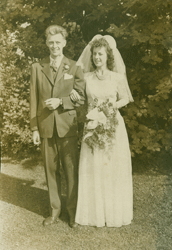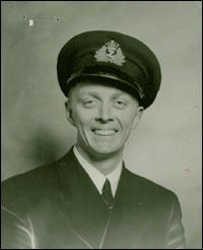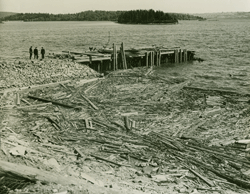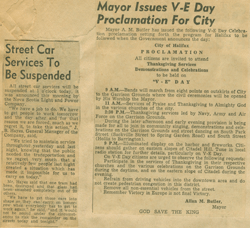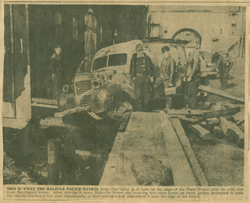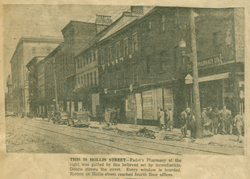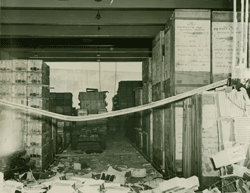Wall of Service
Column
7
Row
31
LT. JOHN FORBES MONROE
Royal Canadian Navy
John Forbes Monroe (Forbes) was born in Ottawa, Ontario, January 29, 1921, the only child of Winifred Edna Forbes and Franklin Alexander Monroe. Residing at 100 Harmer Avenue, Ottawa, he graduated from Glebe Collegiate in 1939. An outstanding competitive tennis player and all round athlete, he was awarded the Ames Memorial Trophy for the outstanding athlete in his senior year. Following graduation, Forbes attended Queen's University (Engineering) in Kingston, Ontario.
With WW II underway, in 1942 he became the Naval Representative for the British Admiralty and was based at a factory near Ajax, Ontario, which produced ammunition and explosives for both the Royal Navy and the Royal Canadian Navy. It was this work that helped shape his career in the Navy - ammunition and explosives became his primary interest and led to his full time preoccupation with them for the remainder of the war.
While in Ajax, he met his wife to be, Jessie Bernice (Bunny) Wight and they were married August 7, 1943. See photo.
Following another brief transfer to Windsor, Ontario, Forbes returned to Ottawa and joined the Royal Canadian Navy Volunteer Reserve as a Lieutenant. See photo.
He was then posted to HMCS Cornwallis in Nova Scotia, and following that, to Halifax. At that time housing was in short supply and many Haligonians were opening up their homes and billeting servicemen and their wives. After much searching, Forbes was finally able to secure lodging with Lee and Lela Rompkey, (Halifax's City Treasurer) at 113 Cambridge Street. With a place to live, Bunny joined Forbes in Halifax in the winter of 1943, obtained employment at Camp Hill Hospital, which housed wounded veterans. In the spring of 1944 he left from Pier 21, bound for England taking passage on one of the 4 stack destroyers which the United States had made available to Canada under lend lease. Crossing the North Atlantic at that time of year in such a vessel was brutal.
Following months of work (ammunition, explosives and mine disposal) at a number of east coast ports and in the English Channel, Forbes witnessed the British and Canadian invasion of France. He was re-deployed back to Canada to take up an appointment in the Naval Ammunition Depot in Halifax. He traveled back across the Atlantic aboard the ship Queen Elizabeth, which was carrying Winston Churchill to New York for a meeting with Roosevelt and Stalin. The Queen Elizabeth carried more guns than most ships of the Canadian Navy (as it was unescorted). Although it was under British command, the guns were manned by U.S. soldiers. The gunnery Commander, being Royal Navy, was quite apprehensive of the U.S. soldiers manning the guns, especially at night. The crossing was relatively fast, as she was traveling alone and at a good clip. After leaving the shop in New York, Forbes traveled back to Canada and on to Halifax to take up his new duties at the Naval Ammunition Depot in Halifax.
From this time until the late spring of 1945, he was in charge of all laboratory work on ammunition and explosives. Periodically he had to deal with calls from people living along the coast who were reporting mines and torpedoes being washed ashore and wanting them removed. Fortunately, most of these turned out to be empty hot water tanks being mistaken for torpedoes and large floatation balls which looked very much like mines. In the rare case that a mine had escaped its mooring and floated ashore, they were normally blown up in Situ, as the shoreline out from Dartmouth and Halifax was fairly isolated from habitation. See photo.
VE Day in Halifax, like many cities and towns throughout Canada, saw the mayor and officials leading Thanksgiving services in churches, parades, music and bands throughout the day and evening. See photo.
Halifax was unique in some respects to other cities, in that there were literally tens of thousands of Army, Navy and Air Force personnel situated in the city, awaiting deployment overseas when the end of the war was announced. A very large number of men were young, not married and were looking for any fun they could find in Halifax before being shipped off to war. In the afternoon, some of the military lads began to break store windows in downtown, particularly the liquor stores, as well as some well-known good clothes stores and 'helped themselves'. It was not long before many people started drinking all natures of liquor, fighting, looting, and setting cars and streetcars on fire - a great deal of destruction resulted. The police and military patrols attempted to deal with the worst people, but the numbers were overpowering, and the situation was very difficult to get under control. See photos.
Forbes, who was at the Ammunition Depot, which had been previously closed for the day, was directed by the Senior Naval Officer in Halifax, to bring a number of men to assist in getting the 'worst' military rioters who were causing damage to the naval storage downtown, under control. He selected several dozen 'large' shore patrol staff and war trained civilian police officers, rounded up a suitable truck to transport them in, and drove downtown. Working until late at night, the men deposited a good number of the drunken sailors in the naval lockup.
The end of the war in Europe saw most ships returning to Canada and in a hurry to unload their ammunition at the Halifax Ammunition Depot, which was already filled beyond its safe capacity. In July of 1945, the inevitable happened. One evening, after virtually hundreds of civilian and naval workers had left at the end day, an explosion occurred on one of the two jetties at the depot. There were only four people inside the Depot at the time, two naval sentries, on each jetty, Forbes and the laboratory foreman. The sentry on duty where the first explosion occurred was killed; the other sentry escaped harm. While Forbes and his foreman were blown up. Fortunately they escaped injury. The explosions and fire continued for the rest of the night and the next two days before being brought under control. See photos.
Two days later the Chief of Naval Staff came down from Ottawa to view the damage and, noted for his sense of humour, said to Forbes "Now that you blew the Depot up, you can stay here and clean it up!". The latter operation extended over a three year period, and following the first year, Forbes was re-assigned to National Defence Headquarters in Ottawa.
Forbes continued his career in government serving at NDHQ and the Treasury Board, and retired in 1980 at the age of 62. Forbes lived in Ottawa with his wife Bunny of 62 years. They had three children, Robin Lee, Murray and Cameron, and now have 5 grandchildren Watson McLeish, Duncan McLeish, Lindsay Monroe, Morgan Monroe and David Monroe.
John Forbes Monroe passed away October 27, 2005, the Year of the Veteran, in Ottawa, at the age of 84.
